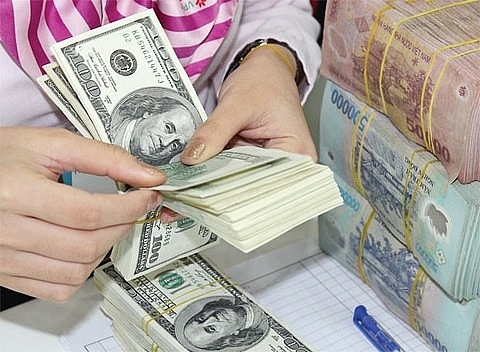Vietnamese dong should be devaluated at moderate rate, says VEPR
 |
| The Vietnam Institute for Economic and Policy Research (VEPR) has suggested devaluing the Vietnamese dong against the US dollar but at a slower rate than the depreciation of China’s yuan against the greenback.-Photo zing.vn |
The recommendation was part of the VEPR’s quarterly report on Vietnam’s macroeconomic policies which was recently released in the context of the US-China trade war.
VEPR experts said that the United States and China were two important trade partners for Vietnam. While the US is Vietnam’s largest export market, accounting for about one-fifth of total export value, China is Vietnam’s largest import market, accounting for about a quarter of total import value.
They said the US-China trade war and the devaluation of the yuan were having huge impacts on the global economy, including Vietnam. By the end of the second quarter of 2018, China’s foreign exchange reserves had fallen by about US$30 billion compared to Q1.
“This may reflect a passive approach by the Central Bank of China (PBoC) during the yuan’s devaluation against the USD. The big possibility is that foreign investors have begun withdrawing capital from China, causing the bank to reduce its foreign exchange reserves to keep the value of yuan,” said experts.
According to Bloomberg, the exchange rate between the CNY and the USD had continued to fall over the past month. At 3pm on July 16, the CNY was fetching only $ 0.1497 ($1 to 6,678 CNY).
Global financial and solutions firm UBS Group AG told Bloomberg that it now saw the yuan dropping to 6.8 by year-end instead of 6.3 as previously forecast.
The VEPR said that as a country that imported a lot of raw materials from China for processing and export, the adjustment to the exchange rates made was beneficial to Vietnam’s raw material importers from China while being adding a bonus to exports to the US.
“Taking advantage of these two big markets could help Vietnam improve its production and trade balance,” said VEPR experts.
Focus on domestic market
The VEPR said that import and export value in the second quarter of this year increased slowly compared with the same period last year, rising 10.2 per cent and 6 per cent on-year, respectively. The trade surplus in Q2 reached approximately $1.4 billion, marking the fourth consecutive quarterly surplus. In the first half of this year, the trade surplus was $ 2.7 billion.
FDI continued to lead the Vietnamese economy with a trade surplus of $8.06 billion, up 34 per cent over the same period last year. Meanwhile, the domestic sector suffered a deficit of $6.66 billion.
In the second quarter, the US overtook the EU to become Vietnam’s largest export market with a turnover of $21.5 billion in the first six months, up 9.2 per cent over the same period last year. It was followed by the EU and China, with $20.5 billion and $16.6 billion, respectively.
China continued to be the largest importer, gaining $31.1 billion (up 15.6 per cent) with mainstream products such as fabric and phones and components helping the northern neighbour overtake South Korea in the first half of 2018.
In the context of the trade war between the US and major partners, the VEPR said that open and small economies like Vietnam would welcome both opportunities and risks.
According to analysis, Vietnam’s trade remained on a positive course in the context of relatively favourable global trade. However, it also put Vietnam at risk if the global economy entered a period of decline due to trade wars. The global financial crisis of 2008 was a lesson for Vietnam.
One solution the VEPR recommended was for businesses to focus on the domestic market and take advantage of increasing purchasing power. If the domestic market’s potential was missed, the possibility of losing out at home to large foreign businesses loomed large.
What the stars mean:
★ Poor ★ ★ Promising ★★★ Good ★★★★ Very good ★★★★★ Exceptional
 Tag:
Tag:
Related Contents
Latest News
More News
- Agribank frames bank credit as catalyst for green growth (December 15, 2025 | 17:59)
- Vietnam’s green transition demands collective financial action (December 15, 2025 | 12:00)
- VIR workshop highlights capital and policy for sustainable development (December 15, 2025 | 11:00)
- Promoting digital assets initiative in Vietnam (December 13, 2025 | 09:30)
- Experts flag gaps as national financial strategy under review (December 12, 2025 | 15:13)
- Global gold exchange models offer roadmap for Vietnamese market (December 12, 2025 | 11:58)
- Five million household businesses to adopt self-declared tax system (December 11, 2025 | 18:13)
- Vietnam establishes management board for crypto asset trading market (December 11, 2025 | 18:11)
- ACB offers financing to fit Vietnam’s textile and garment industry (December 11, 2025 | 09:07)
- Vietnam accelerates push for open banking (December 10, 2025 | 11:58)























 Mobile Version
Mobile Version